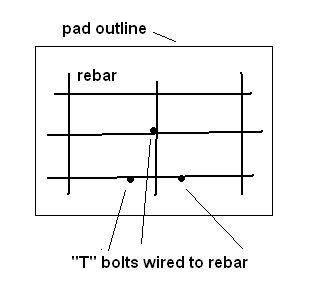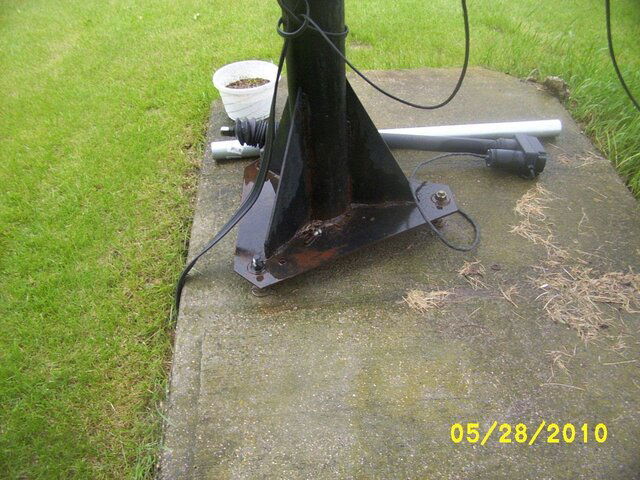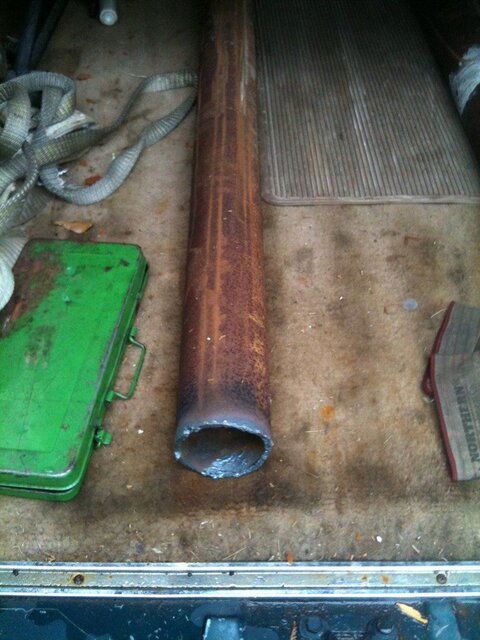Hi guys,
Question. I'm desperate to get those big dishes up so I asked my dad to help me with this as it's not something I can do alone.
Here's what I am trying to put up.
I'm trying to figure out how long the poles need to be.
The 10' dish. I'm figuring it like this. There is like 5' from the center of the dish to the edge. And I need it to be at least 2' off the ground so I can mow beneath it with at least a push mower. So that means I need 7' of pole above the ground to get that clearance. Right? So then there is the problem of below ground. I'm thinking that 5' of pole in the ground with an 18" hole full of cement is just barely going to be enough, considering we get a lot of hurricanes here. We've had some BAD hurricanes too.
My dad tells me that a 12' pole is all he can carry in his van.
Do you think 5' of pole in the ground is enough to hold up a 10' dish?
Then there is the 6' dish. Center to edge is three feet. Add two feet of moving clearance and that's 5' needed above ground. My dad says he can turn down a short piece of pipe to fit the odd size fitting then slip that into a larger pipe and weld it in place. So if he puts an 18" extension in the main pipe that would mean I would only need like 4' of it sticking out of the ground then the turned down extension would give me enough to exceed the 2' of ground clearance.
BUT, how much to put in the ground? Would say, 4' of pipe in the ground with an 18" hole full of cement be enough? Being that the thing is solid, it's going the be a bigger problem with wind, strong storms and hurricanes. But my feeling on it is, it's flimsy, I bent it up pretty good trying to put it together and the first hurricane we get, it will be curb material, IE trashed.
I'm thinking that an 8' pipe would be enough for the smaller dish, 4' in the ground, 4' out and the 18" extension would give me 5' out of the ground.
So if we bought a 12' by 3 1/2 pole and an 8' by 3 1/2 pole, would that get it done right?
Also, how do you figure out how much cement to buy? I know it's going to be a LOT but I don't want to over buy or under buy the stuff, I want to get as close to the right amount as possible with as little waste as possible. I'm sure there's some nifty math trick to figure it out but I'm horrible at math, even basic math gives me grief..
Thank a million!
Question. I'm desperate to get those big dishes up so I asked my dad to help me with this as it's not something I can do alone.
Here's what I am trying to put up.
- 10' aluminum mesh Cband dish
- 6' solid steel Cband dish (the $70 special from a few months back)
I'm trying to figure out how long the poles need to be.
The 10' dish. I'm figuring it like this. There is like 5' from the center of the dish to the edge. And I need it to be at least 2' off the ground so I can mow beneath it with at least a push mower. So that means I need 7' of pole above the ground to get that clearance. Right? So then there is the problem of below ground. I'm thinking that 5' of pole in the ground with an 18" hole full of cement is just barely going to be enough, considering we get a lot of hurricanes here. We've had some BAD hurricanes too.
My dad tells me that a 12' pole is all he can carry in his van.
Do you think 5' of pole in the ground is enough to hold up a 10' dish?
Then there is the 6' dish. Center to edge is three feet. Add two feet of moving clearance and that's 5' needed above ground. My dad says he can turn down a short piece of pipe to fit the odd size fitting then slip that into a larger pipe and weld it in place. So if he puts an 18" extension in the main pipe that would mean I would only need like 4' of it sticking out of the ground then the turned down extension would give me enough to exceed the 2' of ground clearance.
BUT, how much to put in the ground? Would say, 4' of pipe in the ground with an 18" hole full of cement be enough? Being that the thing is solid, it's going the be a bigger problem with wind, strong storms and hurricanes. But my feeling on it is, it's flimsy, I bent it up pretty good trying to put it together and the first hurricane we get, it will be curb material, IE trashed.
I'm thinking that an 8' pipe would be enough for the smaller dish, 4' in the ground, 4' out and the 18" extension would give me 5' out of the ground.
So if we bought a 12' by 3 1/2 pole and an 8' by 3 1/2 pole, would that get it done right?
Also, how do you figure out how much cement to buy? I know it's going to be a LOT but I don't want to over buy or under buy the stuff, I want to get as close to the right amount as possible with as little waste as possible. I'm sure there's some nifty math trick to figure it out but I'm horrible at math, even basic math gives me grief..
Thank a million!






